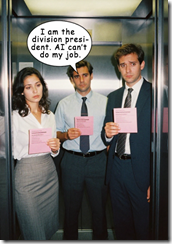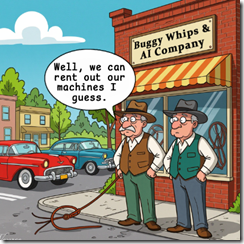Way More Goofs for Waymo: Power Failure? Humans at Fault!
December 23, 2025
 Another dinobaby post. No AI unless it is an image. This dinobaby is not Grandma Moses, just Grandpa Arnold.
Another dinobaby post. No AI unless it is an image. This dinobaby is not Grandma Moses, just Grandpa Arnold.
I found the stories about Google smart Waymo self driving vehicles in the recent San Francisco power failure amusing. Dangerous, yes. A hoot? Absolutely. Google, as its smart software wizards remind us on a PR cadence to make Colgate toothpaste envious, Google is the big dog of smart software. ChatGPT, a loser. Grok, a crazy loser. Chinese open source LLMs. Losers all.
State of the art artificial intelligence makes San Francisco residents celebrate true exceptionalism. Thanks, Venice.ai. Good enough.
I read “Waymo Robotaxis Stop in the Streets during San Francisco Power Outage.” Okay. Google’s Waymo can’t go. Are they electric vehicles suddenly deprived of power? Nope. The smart software did not operate in a way that thrilled riders and motorists when most of San Francisco lost power. The BBC says a very Googley expert said:
"While the Waymo Driver is designed to treat non-functional signals as four-way stops, the sheer scale of the outage led to instances where vehicles remained stationary longer than usual to confirm the state of the affected intersections," a Waymo spokesperson said in a statement provided to the BBC. That "contributed to traffic friction during the height of the congestion," they added.
What other minor issues do the Googley Waymos offer? I noticed the omission of the phrase “out of an abundance of caution.” It is probably out there in some Google quote.
Several observations:
- Google’s wizards will talk about this unlikely event and figure out how to have its cars respond when traffic lights go on the fritz. Will Google be able to fix the problem? Sure. Soon.
- What caused the problem? From Google’s point of view, it was the person responsible for the power failure. Google had nothing to do with that because Google’s Gemini was not autonomously operating the San Francisco power generation system. Someone get on that, please.
- After how many years of testing and how many safe miles (except of course for the bodega cat) will have to pass before Google Waymo does what normal humans would do. Pull over. Or head to a cul de sac in Cow Hollow.
Net net: Google and its estimable wizards can overlook some details. Leadership will take action.
As Elon Musk allegedly said:
"Tesla Robotaxis were unaffected by the SF power outage," Musk posted on X, along with a repost of video showing Waymo vehicles stopped at an intersection with down traffic lights as a line of cars honk and attempt to go around them. Musk also reposted a video purportedly showing a Tesla self-driving car navigating an intersection with non-functioning traffic lights.
Does this mean that Grok is better than Gemini?
Stephen E Arnold, December 23, 2025
France Arrested Pavel. The UK Signals Signal: What Might Follow?
December 23, 2025
 Another dinobaby post. No AI unless it is an image. This dinobaby is not Grandma Moses, just Grandpa Arnold.
Another dinobaby post. No AI unless it is an image. This dinobaby is not Grandma Moses, just Grandpa Arnold.
As a dinobaby, I play no part in the machinations of those in the encrypted messaging arena. On one side, are those who argue that encryption helps preserve a human “right” to privacy. On the other hand, are those who say, “Money laundering, kiddie pix, drugs, and terrorism threaten everything.” You will have to pick your side. That decision will dictate how you interpret the allegedly actual factual information in “Creating Apps Like Signal or WhatsApp Could Be Hostile Activity, Claims UK Watchdog.”

An American technology company leader looks at a UK prison and asks the obvious question. The officers escort the tech titan to the new cell. Thanks, Venice.ai. Close enough for a single horse shoe.
“Hostile activity” suggests bad things will happen if a certain behavior persists. These include:
- Fines
- Prohibitions on an online service in a country (this is popular in Iran among other nation states)
- Potential legal hassles (a Heathrow holding cell is probably the Ritz compared to HMP Woodhill)
The write up reports:
Developers of apps that use end-to-end encryption to protect private communications could be considered hostile actors in the UK.
That is the stark warning from Jonathan Hall KC, the government’s Independent Reviewer of State Threats Legislation and Independent Reviewer of Terrorism Legislation
I interpret this as a helpful summary of a UK government brief titled State Threats Legislation in 2024. The timing of Mr. Hall’s observation may “signal” an overt action. That step may not be on the scale of the French arrest of a Russian with a French passport, but it will definitely create a bit of a stir in the American encrypted messaging sector. Believe it or not, the UK is not thrilled with some organizations’ reluctance to provide information relevant to certain UK legal matters.
In my experience, applying the standard “oh, we didn’t get the email” or “we’ll get back to you, thanks” is unlikely to work for certain UK government entities. Although unfailingly polite, there are some individuals who learned quite particular skills in specialized training. The approach, like the French action, can cause surprise among the individuals identified as problematic.
With certain international tensions rising, the UK may seize an opportunity to apply both PR and legal pressure to overcome what may be seen an impolite and ill advised behavior by certain American companies in the end to end encrypted messaging business.
The article “Creating Apps Like Signal” points out:
In his independent review of the Counter-Terrorism and Border Security Act and the newly implemented National Security Act, Hall KC highlights the incredibly broad scope of powers granted to authorities.
The article adds:
While the report’s strong wording may come as a shock, it doesn’t exist in a vacuum. Encrypted apps are increasingly in the crosshairs of UK lawmakers, with several pieces of legislation targeting the technology. Most notably, Apple was served with a technical capability notice under the Investigatory Powers Act (IPA) demanding it weaken the encryption protecting iCloud data. That legal standoff led the tech giant to disable its Advanced Data Protection instead of creating a backdoor.
What will the US companies do? I learned from the write up:
With the battle lines drawn, we can expect a challenging year ahead for services like Signal and WhatsApp. Both companies have previously pledged to leave the UK market rather than compromise their users’ privacy and security.
My hunch is that more European countries may look at France’s action and the “signals” emanating from the UK and conclude, “We too can take steps to deal with the American companies.”
Stephen E Arnold, December 23, 2025
AI Training: The Great Unknown
December 23, 2025
 Another dinobaby post. No AI unless it is an image. This dinobaby is not Grandma Moses, just Grandpa Arnold.
Another dinobaby post. No AI unless it is an image. This dinobaby is not Grandma Moses, just Grandpa Arnold.
Deloitte used to be an accounting firm. Then the company decided it could so much more. Normal people ask accountants for their opinions. Deloitte, like many other service firms, decided it could just become a general management consulting firm, an information technology company, a conference and event company, and also do the books.
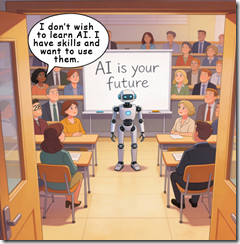
A professional training program for business professionals at a blue chip consulting firm. One person speaks up, but the others keep their thoughts to themselves. How many are updating their LinkedIn profile? How many are wondering if AI will put them out of a job? How many don’t care because the incentives emphasize selling and upselling engagements? Thanks, Venice.ai. Good enough but you are AI and that’s a mark of excellence for some today.
I read an article that suggests a firm like Deloitte is not able to do much of the self assessment and introspection required to make informed decisions that make surprises part of some firms’ standard operating procedure.
This insight appears in “Deloitte’s CTO on a Stunning AI Transformation Stat: Companies Are Spending 93% on Tech and Only 7% on People.” This headline suggests that Deloitte itself is making this error. [Note: This is a wonky link from my feed system. If it disappears, good luck.]
The write up in Fortune Magazine said:
According to Bill Briggs, Deloitte’s chief technology officer, as we move from AI experimentation to impact/value at scale, that fear is driving a lopsided investment strategy where companies are pouring 93% of their AI budget into technology and only 7% into the people expected to use it.
The question that popped into my mind was, “How much money is Deloitte spending relative to smart software on training its staff in AI?” Perhaps the not-so-surprising MBA type “fact” reflects what some Deloitte professionals realize is happening at the esteemed “we can do it in any business discipline” consulting firm?
The explanation is that “the culture, workflow, and training” of a blue chip consulting firm is not extensive. Now with AI finding its way from word processing to looking up a fact, educating employees about AI is given lip service, but is “training” possible. Remember, please, that some consulting firms want those over 55 to depart to retirement. However, what about highly paid experts with being friendly and word smithing their core competencies, can learn how, when, and when not to rely on smart software? Do these “best of the best” from MBA programs have the ability to learn, or are these people situational thinkers; that is, the skill is to be spontaneously helpful, to connect the dots, and reframe what a client tells them so it appears sage-like.
The Deloitte expert says:
“This incrementalism is a hard trap to get out of.”
Is Deloitte out of this incrementalism?
The Deloitte expert (apparently not asked the question by the Fortune reporter) says:
As organizations move from “carbon-based” to “silicon-based” employees (meaning a shift from humans to semiconductor chips, or robots), they must establish the equivalent of an HR process for agents, robots, and advanced AI, and complex questions about liability and performance management. This is going to be hard, because it involves complex questions. He brought up the hypothetical of a human creating an agent, and that agent creating five more generations of agents. If wrongdoing occurs from the fifth generation, whose fault is that? “What’s a disciplinary action? You’re gonna put your line robot…in a timeout and force them to do 10 hours of mandatory compliance training?”
I want to point out that blue chip consulting is a soft skill business. The vaunted analytics and other parade float decorations come from Excel, third parties, or recent hires do the equivalent of college research.
Fortune points to Deloitte and says:
The consequences of ignoring the human side of the equation are already visible in the workforce. According to Deloitte’s TrustID report, released in the third quarter, despite increasing access to GenAI in the workplace, overall usage has actually decreased by 15%. Furthermore, a “shadow AI” problem is emerging: 43% of workers with access to GenAI admit to noncompliance, bypassing employer policies to use unapproved tools. This aligns with previous Fortune reporting on the scourge of shadow AI, as surveys show that workers at up to 90% of companies are using AI tools while hiding that usage from their IT departments. Workers say these unauthorized tools are “easier to access” and “better and more accurate” than the approved corporate solutions. This disconnect has led to a collapse in confidence, with corporate worker trust in GenAI declining by 38% between May and July 2025. The data supports this need for a human-centric approach. Workers who received hands-on AI training and workshops reported 144% higher trust in their employer’s AI than those who did not.
Let’s get back to the question? Is Deloitte training its employees in AI so the “information” sticks and then finds its way into engagements? This passage seems to suggest that the answer is, “No for Deloitte. No for its clients. And no for most organizations.” Judge for yourself:
For Briggs [the Deloitte wizard], the message to the C-suite is clear: The technology is ready, but unless leaders shift their focus to the human and cultural transformation, they risk being left with expensive technology that no one trusts enough to use.
My take is that the blue chip consulting firms are:
- Trying to make AI good enough so headcount and other cost savings like health care can be reduced
- Selling AI consulting to their clients before knowing what will and won’t work in a context different from the consulting firms’
- Developing an understanding that AI cannot do what humans can do; that is, build relationships and sell engagements.
Sort of a pickle.
Stephen E Arnold, December 23, 2025
How to Get a Job in the Age of AI?
December 23, 2025
 Another dinobaby post. No AI unless it is an image. This dinobaby is not Grandma Moses, just Grandpa Arnold.
Another dinobaby post. No AI unless it is an image. This dinobaby is not Grandma Moses, just Grandpa Arnold.
Two interesting employment related articles appeared in my newsfeeds this morning. Let’s take a quick look at each. I will try to add some humor to these write ups. Some may find them downright gloomy.
The first is “An OpenAI Exec Identifies 3 Jobs on the Cusp of Being Automated.” I want to point out that the OpenAI wizard’s own job seems to be secure from his point of view. The write up points out:
Olivier Godement, the head of product for business products at the ChatGPT maker, shared why he thinks a trio of jobs — in life sciences, customer service, and computer engineering — is on the cusp of automation.
Let’s think about each of these broad categories. I am not sure what life sciences means in OpenAI world. The term is like a giant umbrella. Customer service makes some sense. Companies were trying to ignore, terminate, and prevent any money sucking operation related to answer customer’s questions and complaints for years. No matter how lousy and AI model is, my hunch is that it will be slapped into a customer service role even if it is arguably worse than trying to understand the accent of a person who speaks English as a second or third language.
Young members of “leadership” realize that the AI system used to replace lower-level workers has taken their jobs. Selling crafts on Etsy.com is a career option. Plus, there is politics and maybe Epstein, Epstein, Epstein related careers for some. Thanks, Qwen, you just output a good enough image but you are free at this time (December 13, 2025).
Now we come to computer engineering. I assume the OpenAI person will position himself as an AI adept, which fits under the umbrella of computer engineering. My hunch is that the reference is to coders who do grunt work. The only problem is that the large language model approach to pumping out software can be problematic in some situations. That’s why the OpenAI person is probably not worrying about his job. An informed human has to be in the process of machine-generated code. LLMs do make errors. If the software is autogenerated for one of those newfangled portable nuclear reactors designed to power football field sized data centers, someone will want to have a human check that software. Traditional or next generation nuclear reactors can create some excitement if the software makes errors. Do you want a thorium reactor next to your domicile? What about one run entirely by smart software?
What’s amusing about this write up is that the OpenAI person seems blissfully unaware of the precarious financial situation that Sam AI-Man has created. When and if OpenAI experiences a financial hiccup, will those involved in business products keep their jobs. Oliver might want to consider that eventuality. Some investors are thinking about their options for Sam AI-Man related activities.
The second write up is the type I absolutely get a visceral thrill writing. A person with a connection (probably accidental or tenuous) lets me trot out my favorite trope — Epstein, Epstein, Epstein — as a way capture the peculiarity of modern America. This article is “Bill Gates Predicts That Only Three Jobs Will Be Safe from Being Replaced by AI.” My immediate assumption upon spotting the article was that the type of work Epstein, Epstein, Epstein did would not be replaced by smart software. I think that impression is accurate, but, alas, the write up did not include Epstein, Epstein, Epstein work in its story.
What are the safe jobs? The write up identifies three:
-
Biology. Remember OpenAI thinks life sciences are toast. Okay, which is correct?
-
Energy expertise
-
Work that requires creative and intuitive thinking. (Do you think that this category embraces Epstein, Epstein, Epstein work? I am not sure.)
The write up includes a statement from Bill Gates:
“You know, like baseball. We won’t want to watch computers play baseball,” he said. “So there’ll be some things that we reserve for ourselves, but in terms of making things and moving things, and growing food, over time, those will be basically solved problems.”
Several observations:
-
AI will cause many people to lose their jobs
-
Young people will have to make knick knacks to sell on Etsy or find equally creative ways of supporting themselves
-
The assumption that people will have “regular” jobs, buy houses, go on vacations, and do the other stuff organization man type thinking assumed was operative, is a goner.
Where’s the humor in this? Epstein, Epstein, Epstein and OpenAI debt, OpenAI debt, and OpenAI debt. Ho ho ho.
Stephen E Arnold, December x, 2025
Telegram News: AlphaTON, About Face
December 22, 2025
 Another dinobaby post. No AI unless it is an image. This dinobaby is not Grandma Moses, just Grandpa Arnold.
Another dinobaby post. No AI unless it is an image. This dinobaby is not Grandma Moses, just Grandpa Arnold.
Starting in January 2026, my team and I will be writing about Telegram’s Cocoon, the firm’s artificial intelligence push. Unlike the “borrow, buy, hype, and promise” approach of some US firms, Telegram is going a different direction. For Telegram, it is early days for smart software. The impact will be that posts in Beyond Search will decrease beginning Christmas week. The new Telegram News posts will be on a different url or service. Our preliminary tests show that a different approach won’t make much difference to the Arnold IT team. Frankly I am not sure how people will find the new service. I will post the links on Beyond Search, but with the exceptional indexing available from Bing, Google, et al, I have zero clue if these services will find our Telegram Notes.
Why am I making this shift?
Here’s one example. With a bit of fancy footwork, a publicly traded company popped into existence a couple of months ago. Telegram itself does not appear to have any connection to this outfit. However, the TON Foundation’s former president set up an outfit called the TON Strategy Co., which is listed on the US NASDAQ. Then following a similar playbook, AlphaTON popped up to provide those who believe in TONcoin a way to invest in a financial firm anchored to TONcoin. Yeah, I know that having these two public companies semi-linked to Telegram’s TON Foundation is interesting.
But even more fascinating is the news story about AlphaTON using some financial fancy dancing to link itself to Andruil. This is one of the companies familiar to those who keep track of certain Silicon Valley outfits generating revenue from Department of War contracts.
What’s the news?
The deal is off. According to “AlphaTON Capital Corp Issues Clarification on Anduril Industries Investment Program.” The word clarification is not one I would have chosen. The deal has vaporized. The write up says:
It has now come to the Company’s attention that the Anduril Industries common stock underlying the economic exposure that was contractually offered to our Company is subject to transfer restrictions and that Anduril will not consent to any such transfer. Due to these material limitations and risk on ownership and transferability, AlphaTON has made the decision to cancel the Anduril tokenized investment program and will not be proceeding with the transaction. The Company remains committed to strategic investments and the tokenization of desirable assets that provide clear ownership rights and align with shareholder value creation objectives.
I interpret this passage to mean, “Fire, Aim, Ready Maybe.”
With the stock of AlphaTON Capital as of December 18, 2025, at about $0.70 at 11 30 am US Eastern, this fancy dancing may end this set with a snappy rendition of Mozart’s Requiem.
That’s why Telegram Notes will be an interesting organization to follow. We think Pavel Durov’s trial in France, the two or maybe one surviving public company, two “foundations” linked to Telegram, and the new Cocoon AI play are going to be more interesting. If Mr. Durov goes to jail, the public company plays fail, and the Cocoon thing dies before it becomes a digital butterfly, I may flow more stories to Beyond Search.
Stay tuned.
Stephen E Arnold, December 22, 2025
How Do You Get Numbers for Copilot? Microsoft Has a Good Idea
December 22, 2025
 Another dinobaby post. No AI unless it is an image. This dinobaby is not Grandma Moses, just Grandpa Arnold.
Another dinobaby post. No AI unless it is an image. This dinobaby is not Grandma Moses, just Grandpa Arnold.
In past couple of days, I tested some of the latest and greatest from the big tech outfits destined to control information flow. I uploaded text to Gemini, asked it a question answered in the test, and it spit out the incorrect answer. Score one for the Googlers. Then I selected an output from ChatGPT and asked it to determine who was really innovating in a very, very narrow online market space. ChatGPT did not disappoint. It just made up a non-existent person. Okay Sam AI-Man, I think you and Microsoft need to do some engineering.
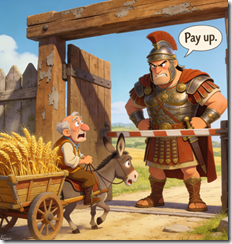
Could a TV maker charge users to uninstall a high value service like Copilot? Could Microsoft make the uninstall app available for a fee via its online software store? Could both the TV maker and Microsoft just ignore the howls of the demented few who don’t love Copilot? Yeah, I go with ignore. Thanks, Venice.ai. Good enough.
And what did Microsoft do with its Copilot online service? According to Engadget, “LG quietly added an unremovable Microsoft Copilot app to TVs.” The write up reports:
Several LG smart TV owners have taken to Reddit over the past few days to complain that they suddenly have a Copilot app on the device
But Microsoft has a seductive way about its dealings. Engadget points out:
[LG TV owners] cannot uninstall it.
Let’s think about this. Most smart TVs come with highly valuable to the TV maker baloney applications. These can be uninstalled if one takes the time. I don’t watch TV very much, so I just leave the set the way it was. I routinely ignore pleas to update the software. I listen, so I don’t care if weird reminders obscure the visuals.
The Engadget article states:
LG said during the 2025 CES season that it would have a Copilot-powered AI Search in its next wave of TV models, but putting in a permanent AI fixture is sure to leave a bad taste in many customers’ mouths, particularly since Copilot hasn’t been particularly popular among people using AI assistants.
Okay, Microsoft has a vision for itself. It wants to be the AI operating system just as Google and other companies desire. Microsoft has been a bit pushy. I suppose I would come up with ideas that build “numbers” and provide fodder for the Microsoft publicity machine. If I hypothesize myself in a meeting at Microsoft (where I have been but that was years ago), I would reason this way:
- We need numbers.
- Why not pay a TV outfit to install Copilot.
- Then either pay more or provide some inducements to our TV partner to make Copilot permanent; that is, the TV owner has no choice.
The pushback for this hypothetical suggestion would be:
- How much?
- How many for sure?
- How much consumer backlash?
I further hypothesize that I would say:
- We float some trial balloon numbers and go from there.
- We focus on high end models because those people are more likely to be willing to pay for additional Microsoft services
- Who cares about consumer backlash? These are TVs and we are cloud and AI people.
Obviously my hypothetical suggestion or something similar to it took place at Microsoft. Then LG saw the light or more likely the check with some big numbers imprinted on it, and the deal was done.
The painful reality of consumer-facing services is that something like 95 percent of the consumers do not change the defaults. By making something uninstallable will not even register as a problem for most consumers.
Therefore, the logic of the LG play is rock solid. Microsoft can add the LG TVs with Copilot to its confirmed Copilot user numbers. Win.
Microsoft is not in the TV business so this is just advertising. Win
Microsoft is not a consumer product company like a TV set company. Win.
As a result, the lack of an uninstall option makes sense. If a lawyer or some other important entity complains, making Copilot something a user can remove eliminates the problem.
Love those LGs. Next up microwaves, freezers, smart lights, and possibly electric blankets. Numbers are important. Users demonstrate proof that Microsoft is on the right path.
But what about revenue from Copilot. No problem. Raise the cost of other services. Charging Outlook users per message seems like an idea worth pursuing? My hypothetical self would argue with type of toll or taxi meter approach. A per pixel charge in Paint seems plausible as well.
The reality is that I believe LG will backtrack. Does it need the grief?
Stephen E Arnold, December 22, 2025
Modern Management Method with and without Smart Software
December 22, 2025
 Another dinobaby post. No AI unless it is an image. This dinobaby is not Grandma Moses, just Grandpa Arnold.
Another dinobaby post. No AI unless it is an image. This dinobaby is not Grandma Moses, just Grandpa Arnold.
I enjoy reading and thinking about business case studies. The good ones are few and far between. Most are predictable, almost as if the author was relying on a large language model for help.
“I’m a Tech Lead, and Nobody Listens to Me. What Should I Do?” is an example of a bright human hitting on tactics to become more effective in his job. You can work through the full text of the article and dig out the gems that may apply to you. I want to focus on two points in the write up. The first is the matrix management diagram based on or attributed to Spotify, a music outfit. The second is a method for gaining influence in a modern, let’s go fast company.
Here’s the diagram that caught my attention:
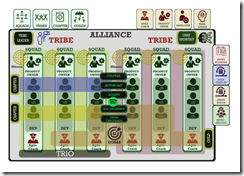
Instead of the usual business school lingo, you will notice “alliance,” “tribe,” “squad,” and “trio.” I am not sure what these jazzy words mean, but I want to ask you a question, “Looking at this matrix, who is responsible when a problem occurs?” Take you time. I did spend some time looking at this chart, and I formulated several hypotheses:
- The creator wanted to make sure that a member of leadership would have a tough time figuring out who screwed up. If you disagree, that’s okay. I am a dinobaby, and I like those old fashioned flow diagrams with arrows and boxes. In those boxes is the name of the person who has to fix a problem. I don’t know about one’s tribe. I know Problem A is here. Person B is going to fix it. Simple.
- The matrix as displayed allows a lot of people to blame other people. For example, what if the coach is like the leader of the Cleveland Browns, who brilliantly equipped a young quarterback with the incorrect game plan for the first quarter of a football game. Do we blame the coach or do we chase down a product owner? What if the problem is a result of a dependency screw up involving another squad in a different tribe? In practical terms, there is no one with direct responsibility for the problem. Again: Don’t agree? That’s okay.
- The matrix has weird “leadership” or “employment categories” distributed across the X axes at the top of the chart. What’s a chapter? What’s an alliance? What’s self organized and autonomous in a complex technical system? My view is that this is pure baloney designed to make people feel important yet shied any one person from responsibility. I bet some reading this numbered point find my statement out of line. Tough.
The diagram makes clear that the organization is presented as one that will just muddle forward. No one will have responsibility when a problem occurs? No one will know how to fix the problem without dropping other work and reverse engineering what is happening. The chart almost guarantees bafflement when a problem surfaces.
The second item I noticed was this statement or “learning” from the individual who presented the case example. Here’s the passage:
When you solve a real problem and make it visible, people join in. Trust is also built that way, by inviting others to improve what you started and celebrating when they do it better than you.
For this passage hooks into the one about solving a problem; to wit:
Helping people debug. I have never considered myself especially smart, but I have always been very systematic when connecting error messages, code, hypotheses, and system behavior. To my surprise, many people saw this as almost magical. It was not magic. It was a mix of experience, fundamentals, intuition, knowing where to look, and not being afraid to dive into third-party library code.
These two passages describe human interactions. Working with others can result in a collective effort greater than the sum of its parts. It is a human manifestation. One fellow described this a interaction efflorescence. Fancy words for what happens when a few people face a deadline and severe consequences for failure.
Why did I spend time pointing out an organizational structure purpose built to prevent assigning responsibility and the very human observations of the case study author?
The answer is, “What will happen when smart software is tossed into this management structure?” First, people will be fired. The matrix will have lots of empty boxes. Second, the human interaction will have to adapt to the smart software. The smart software is not going to adapt to humans. Don’t believe me. One smart software company defended itself by telling a court it is in our terms of service that suicide in not permissible. Therefore, we are not responsible. The dead kid violated the TOS.
How functional will the company be as the very human insight about solving real problems interfaces with software? Man machine interface? Will that be an issue in a go fast outfit? Nope. The human will be excised as a consequence of efficiency.
Stephen E Arnold, December 23, 2025
Poor Meta! Allegations about Accepting Scam Advertising
December 19, 2025
 Another dinobaby post. No AI unless it is an image. This dinobaby is not Grandma Moses, just Grandpa Arnold.
Another dinobaby post. No AI unless it is an image. This dinobaby is not Grandma Moses, just Grandpa Arnold.
That well managed, forward leaning, AI and goggle centric company is in the news again. This time the focus is advertising that is scammy. “Mark Zuckerberg’s Meta Allows Rampant Scam Ads from China While Raking in Billions, Explosive Report Says” states:
According to an investigation by Reuters, Meta earned more than $3 billion in China last year through scam ads for illegal gambling, pornography, and other inappropriate content. That figure represents nearly 19 percent of the company’s $18 billion in total ad revenue from China during the same period. Reuters had previously reported that 10 percent of Meta’s global revenue came from fraudulent ads.
The write up makes a pointed statement:
The investigation suggests Meta knew about the scale of the ad fraud problem on its platforms, but chose not to act because it would have affected revenue.

Guess what happens when senior managers at a large social media outfit pay little attention to what happens around them? Thanks, ChatGPT, good enough.
Let’s assume that the allegations are accurate and verifiable. The question is, “Why did Meta take in billions from scam ads?” My view is that there were several reasons:
- Revenue
- Figuring out what is and is not “spammy” is expensive. Spam may be like the judge’s comment years ago, “I will know it when I see it.” Different people have different perceptions
- Changing the ad sales incentive programs is tricky, time consuming, and expensive.
The logical decision is, based on my limited understanding of how managerial decisions are made at Meta simple: Someone may have said, “Hey, keep doing it until someone makes us stop.”
Why would a very large company adopt this hypothetical response to spammy ads?
My hunch is that management looked the other way. Revenue is important.
Stephen E Arnold, December 19, 2025
First, Virtual AI Compute and Now a Virtual Supercomputation Complex
December 19, 2025
 Another dinobaby post. No AI unless it is an image. This dinobaby is not Grandma Moses, just Grandpa Arnold.
Another dinobaby post. No AI unless it is an image. This dinobaby is not Grandma Moses, just Grandpa Arnold.
Do you remember the good old days at AT&T? No Judge Green. No Baby Bells. Just the Ma Bell. Devices were boxes or plastic gizmos. Western Electric paid people to throw handsets out of a multi story building to make sure the stuff was tough. That was the old Ma Bell. Today one has virtual switches, virtual exchanges, and virtual systems. Software has replaced quite a bit of the fungible.
A few days ago, Pavel Durov rolled out his Cocoon. This is a virtual AI complex or VAIC. Skip that build out of data centers. Telegram is using software to provide an AI compute service to anyone with a mobile device. I learned today (December 6, 2025) that Stephen Wolfram has rolled out “instant supercompute.”
When those business plans don’t work out, the buggy whip boys decide to rent out their factory and machines. Too bad about those new fangled horseless carriages. Will the AI data center business work out? Stephen Wolfram and Pavel Durov seem to think that excess capacity is a business opportunity. Thanks, Venice.ai. Good enough.
A Mathematica user wants to run a computation at scale. According to “Instant Supercompute: Launching Wolfram Compute Services”:
Well, today we’ve released an extremely streamlined way to do that. Just wrap the scaled up computation in RemoteBatchSubmit and off it’ll go to our new Wolfram Compute Services system. Then—in a minute, an hour, a day, or whatever—it’ll let you know it’s finished, and you can get its results. For decades I’ve often needed to do big, crunchy calculations (usually for science). With large volumes of data, millions of cases, rampant computational irreducibility, etc. I probably have more compute lying around my house than most people—these days about 200 cores worth. But many nights I’ll leave all of that compute running, all night—and I still want much more. Well, as of today, there’s an easy solution—for everyone: just seamlessly send your computation off to Wolfram Compute Services to be done, at basically any scale.
And the payoff to those using Mathematica for big jobs:
One of the great strengths of Wolfram Compute Services is that it makes it easy to use large-scale parallelism. You want to run your computation in parallel on hundreds of cores? Well, just use Wolfram Compute Services!
One major point in the announcement is:
Wolfram Compute Services is going to be very useful to many people. But actually it’s just part of a much larger constellation of capabilities aimed at broadening the ways Wolfram Language can be used…. An important direction is the forthcoming Wolfram HPCKit—for organizations with their own large-scale compute facilities to set up their own back ends to RemoteBatchSubmit, etc. RemoteBatchSubmit is built in a very general way, that allows different “batch computation providers” to be plugged in.
Does this suggest that Supercompute is walking down the same innovation path as Pavel and Nikolai Durov? I seem some similarities, but there are important differences. Telegram’s reputation is enhanced with some features of considerable value to a certain demographic. Wolfram Computer Services is closely associated with heavy duty math. Pavel Durov awaits trial in France on more than a dozen charges of untoward online activities. Stephen Wolfram collects awards and gives enthusiastic if often incomprehensible talks on esoteric subjects.
But the technology path is similar in my opinion. Both of these organizations want to use available compute resources; they are not too keen on buying GPUs, building data centers, and spending time in meetings about real estate.
The cost of running a job on the Supercompute system depends on a number of factors. A user buys “credits” and pays for a job with those. No specific pricing details are available to me at this time: 0800 US Eastern on December 6, 2025.
Net net: Two very intelligent people — Stephen Wolfram and Pavel Durov — seem to think that the folks with giant data centers will want to earn some money. Messrs. Wolfram and Durov are resellers of excess computing capacity. Will Amazon, Google, Microsoft, et al be signing up if the AI demand does not meet the somewhat robust expectations of big AI tech companies?
Stephen E Arnold, December 19, 2025
Windows Strafed by Windows Fanboys: Incredible Flip
December 19, 2025
 Another dinobaby post. No AI unless it is an image. This dinobaby is not Grandma Moses, just Grandpa Arnold.
Another dinobaby post. No AI unless it is an image. This dinobaby is not Grandma Moses, just Grandpa Arnold.
When the Windows folding phone came out, I remember hunting around for blog posts, podcasts, and videos about this interesting device. Following links I bumbled onto the Windows Central Web site. The two fellows who seemed to be front and center had a podcast (a quite irregularly published podcast I might add). I was amazed at the pro-folding gizmo. One of the write ups was panting with excitement. I thought then and think now that figuring out how to fold a screen is a laboratory exercise, not something destined to be part of my mobile phone experience.
I forgot about Windows Central and the unflagging ability to find something wonderfully bigly about the Softies. Then I followed a link to this story: “Microsoft Has a Problem: Nobody Wants to Buy or Use Its Shoddy AI Products — As Google’s AI Growth Begins to Outpace Copilot Products.”

An athlete failed at his Dos Santos II exercise. The coach, a tough love type, offers the injured gymnast a path forward with Mistral AI. Thanks, Qwen, do you phone home?
The cited write up struck me as a technology aficionado pulling off what is called a Dos Santos II. (If you are not into gymnastics, this exercise “trick” involves starting backward with a half twist into a double front in the layout position. Boom. Perfect 10. From folding phone to “shoddy AI products.”
If I were curious, I would dig into the reasons for this change in tune, instruments, and concert hall. My hunch is that a new manager replaced a person who was talking (informally, of course) to individuals who provided the information without identifying the source. Reuters, the trust outfit, does this on occasion as do other “real” journalists. I prefer to say, here are my observations or my hypotheses about Topic X. Others just do the “anonymous” and move forward in life.
Here are a couple of snips from the write up that I find notable. These are not quite at the “shoddy AI products” level, but I find them interesting.
Snippet 1:
If there’s one thing that typifies Microsoft under CEO Satya Nadella‘s tenure: it’s a general inability to connect with customers. Microsoft shut down its retail arm quietly over the past few years, closed up shop on mountains of consumer products, while drifting haphazardly from tech fad to tech fad.
I like the idea that Microsoft is not sure what it is doing. Furthermore, I don’t think Microsoft every connected with its customers. Connections come from the Certified Partners, the media lap dogs fawning at Microsoft CEO antics, and brilliant statements about how many Russian programmers it takes to hack into a Windows product. (Hint: The answer is a couple if the Telegram posts I have read are semi accurate.)
Snippet 2:
With OpenAI’s business model under constant scrutiny and racking up genuinely dangerous levels of debt, it’s become a cascading problem for Microsoft to have tied up layer upon layer of its business in what might end up being something of a lame duck.
My interpretation of this comment is that Microsoft hitched its wagon to one of AI’s Cybertrucks, and the buggy isn’t able to pull the Softie’s one-horse shay. The notion of a “lame duck” is that Microsoft cannot easily extricate itself from the money, the effort, the staff, and the weird “swallow your AI medicine, you fool” approach the estimable company has adopted for Copilot.
Snippet 3:
Microsoft’s “ship it now fix it later” attitude risks giving its AI products an Internet Explorer-like reputation for poor quality, sacrificing the future to more patient, thoughtful companies who spend a little more time polishing first. Microsoft’s strategy for AI seems to revolve around offering cheaper, lower quality products at lower costs (Microsoft Teams, hi), over more expensive higher-quality options its competitors are offering. Whether or not that strategy will work for artificial intelligence, which is exorbitantly expensive to run, remains to be seen.
A less civilized editor would have dropped in the industry buzzword “crapware.” But we are stuck with “ship it now fix it later” or maybe just never. So far we have customer issues, the OpenAI technology as a lame duck, and now the lousy software criticism.
Okay, that’s enough.
The question is, “Why the Dos Santos II” at this time? I think citing the third party “Information” is a convenient technique in blog posts. Heck, Beyond Search uses this method almost exclusively except I position what I do as an abstract with critical commentary.
Let my hypothesize (no anonymous “source” is helping me out):
- Whoever at Windows Central annoyed a Softie with power created is responding to this perceived injustice
- The people at Windows Central woke up one day and heard a little voice say, “Your cheerleading is out of step with how others view Microsoft.” The folks at Windows Central listened and, thus, the Dos Santos II.
- Windows Central did what the auth9or of the article states in the article; that is, using multiple AI services each day. The Windows Central professional realized that Copilot was not as helpful writing “real” news as some of the other services.
Which of these is closer to the pin? I have no idea. Today (December 12, 2025) I used Qwen, Anthropic, ChatGPT, and Gemini. I want to tell you that these four services did not provide accurate output.
Windows Central gets a 9.0 for its flooring Microsoft exercise.
Stephen E Arnold, December 19, 2025


